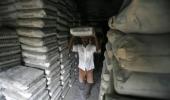'I believe that as we produce more, our cost will come down further. We will maintain our competitiveness.'

In September 2022, the Adani group became the new promoters of ACC and Ambuja Cements, making the conglomerate the country's second-largest cement producer overnight.
Ajay Kapur, chief executive officer (CEO), cement business, Adani group, in a face-to-face interview with Amritha Pillay/Business Standard, talks about price war and how the company hopes to tackle related-party transactions (RPT), among other things.
The Adani group entered the cement sector in September last year, since speculation about a price war started. We have not seen one so far. What is your outlook?
I think India should grow at 6-7 per cent of gross domestic product (GDP) in the next 10 years but cement may continue to trail.
Earlier, it used to be 1.3 times the GDP growth.
I am seeing corporate investment coming back.
You still have a lot of demand in the housing sector.
Add to it the infra push, a 7- 8 per cent compound annual growth rate (CAGR) cannot be not ruled out.
With a 420 million-tonne demand base -- at 8 or 10 per cent growth -- you will need about 35 million tonnes of extra cement to be produced. There is not a major worry on the price front.
So, you don't see any aggressive pricing?
During the past 12 months, we saw one of the highest capacity additions. Any producer would want to recover his cost and also deliver returns to shareholders. That is what we are all here for.
Does Adani Cement desire to become the largest cement manufacturer in the country?
Every business we are in, we have been one of the most efficient and also one of the most preferred partners for customers. We would like to continue with that.
Tell us more about the cost rationalisation efforts. Your employee costs, for instance, have fallen.
Earlier, the two companies had one management committee each for ACC and Ambuja and the regional structures.
There was one CEO each for ACC and Ambuja, and likewise the function heads.
We already have a master supply agreement with shareholders, and this allows us to optimise each other's assets.
So, the day we took over on September 16, 2022, a circular was sent with a common structure at the top.
But we have kept the frontline intact. That is why you find that costs have reduced.
We still believe that we don't have any issues in terms of key people.
We are recruiting big time in our frontline sales, commercial marketing roles.
At 4.5 per cent of cost-to-sales, I believe that as we produce more, our cost will come down further. We will maintain our competitiveness.
The master supply agreement (MSA) was entered into in 2018 but the earlier promoters could not take it to its full potential.
Tell us about the savings made during the time of the earlier promoters compared to now.
A good beginning was made by Holcim. However, when we came in, we also felt that we could give that extra push.
So, we said we'll make it more lean and make the management accountable.
And, we will not have two leaders chasing the same goal. We have obtained twice the savings from the MSA compared to what it was earlier.
You don't have any plans for merging ACC & Ambuja?
A merger at the moment is not on the agenda at all. We have already optimised the entire value through the MSA.
How about synergies at the group level? A concern analysts often raise is how different will listed group entities navigate related-party transactions?
We believe there are seven or eight areas where there are adjacencies (within the group).
As a CEO of a cement company, I am now excited about being a part of an infrastructure group.
For instance, the knowledge of shipping and ports is now available on my phone or by speaking to my colleagues.
No RPT tells me not to talk to my colleagues.
You are also expecting further cost savings as you approach greener initiatives?
The real savings will happen as we expand our footprint -- that is, we go from 70 million tonnes (mt) to 140 mt.
Each of the new plants are being built at the lowest cost with the waste heat recovery system (WHRS) and solar power.
They will be based on the circular economy where we use alternative fuel.
We will produce green cement that way and continue to be the leader in blended cement.
So, we will continue to use a lot of fly ash, slag and whatever else we can get through research and development. This can give us a good product.
Do you see the Indian cement market as a three-player one by 2030?
I believe India will need almost 650 million tonnes and no one company will be able to produce that.
It also needs a lot of resources. At the national level, you will have four or five major players.
And in some regions, you have one or two dominant players.
Feature Presentation: Aslam Hunani/Rediff.com










